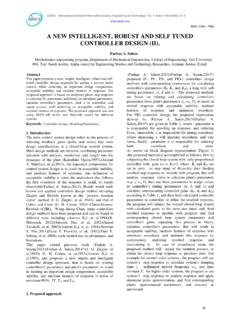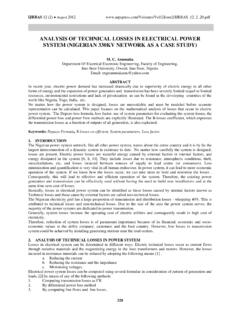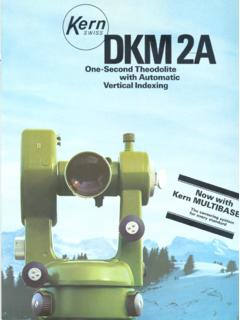Transcription of Rock Engineering Practice & Design - ISRM
1 Rock EngineeringRock EngineeringPractice & DesignPractice & DesignLecture 4: Lecture 4: Kiti A l i I Kiti A l i I Kinematic Analysis I Kinematic Analysis I (Slopes)(Slopes)1 of 36 Erik Eberhardt UBC Geological Engineering ISRM EditionAuthor s Note:Author s Note:The lecture slides provided here are taken from the course Geotechnical Engineering Practice , which is part of the 4th year Geological Engineering program at the University of British Columbia (V C d ) Th k ii d (Vancouver, Canada). The course covers rock Engineering and geotechnical Design methodologies, building on those already taken by the students covering Introductory Rock Mechanics and Advanced Rock Mechanics Rock Mechanics. Although the slides have been modified in part to add context, they of course are missing the detailed narrative that accompanies any l l d h h l lecture.
2 It is also recognized that these lectures summarize, reproduce and build on the work of others for which gratitude is extended. Where possible, efforts have been made to acknowledge th v ri us s urc s ith list f r f r nc s b in pr vid d t th the various sources, with a list of references being provided at the end of each lecture. Errors, omissions, comments, etc., can be forwarded to the 2 of 36 Erik Eberhardt UBC Geological Engineering ISRM EditionErrors, omissions, comments, etc., can be forwarded to the author at: Slope Rock Slope Continuum or Continuum or DiscontinuumDiscontinuum?? dl d k l f l ll dd In a moderately jointed rock mass, slope failure is generally dictated directly by the presence of discontinuities, which act as planes of weakness within the rock mass. These interact to control the size and the direction of movement of the slope failure.
3 Direction of movement of the slope failure. planar failure 3 of 36 Erik Eberhardt UBC Geological Engineering ISRM Editionwedge failure Discontinuity MappingDiscontinuity MappingScanline mappingson (1997)son & HarrisHudsWindow mapping4 of 36 Erik Eberhardt UBC Geological Engineering ISRM EditionDiscontinuity MappingDiscontinuity Mapping5 of 36 Erik Eberhardt UBC Geological Engineering ISRM EditionWyllie & Mah (2004)Discontinuity Mapping Discontinuity Mapping Remote SensingRemote SensingStrouth & Eberhardt (2006)Remote sensing techniques like LiDAR and phtogrammetry, provide a means to collect rock mass data from slopes that would otherwise be inaccessible or dangerous Discontinuity orientation persistence and spacing data can 6 of 36 Erik Eberhardt UBC Geological Engineering ISRM Editionor dangerous. Discontinuity orientation, persistence, and spacing data can be extracted from the 3-D point cloud of the scanned surface.
4 Stereonets Stereonets Pole PlotsPole PlotsPlotting dip and dip direction pole plots provide an immediate visual Plotting dip and dip direction, pole plots provide an immediate visual depiction of pole concentrations. All natural discontinuities have a certain variability in their orientation that results in scatterof the pole plots. However, by contouring the pole plot, the most highly concentrated areas of poles, representing the dominantdiscontinuity sets, can be identified. It must be remembered though, that it may be difficult to distinguishwhich set a particular discontinuity belongs to or that in some cases a singlediscontinuity 7 of 36 Erik Eberhardt UBC Geological Engineering ISRM Editiona particular discontinuity belongs to or that in some cases a singlediscontinuity may be the controlling factoras opposed to a set of Plots & Modes of Slope InstabilityPole Plots & Modes of Slope InstabilityTypical pole plots for different modes of rock slope failure.
5 8 of 36 Erik Eberhardt UBC Geological Engineering ISRM EditionWyllie & Mah (2004)Discontinuity PersistenceDiscontinuity PersistencePersistencerefers to the areal extent or sizeof a discontinuity plane Persistencerefers to the areal extent or sizeof a discontinuity plane withina plane. Clearly, the persistence will have a major influence on the shear strength developed in the plane of the discontinuity, where the intact rock segments are referred to as rock bridges . ggk rock bridge9 of 36 Erik Eberhardt UBC Geological Engineering ISRM Editionincreasing persistenceDiscontinuity PersistenceDiscontinuity PersistenceTogether with spacing, discontinuity persistencehelps to define the size of blocks that can slide from a rock face. Several procedures have been developed to calculate persistence by measuring their exposed to calculate persistence by measuring their exposed trace lengthson a specified area of the 1:define a mapping area on the rock face scan Step 1define a mapping area on the rock face with dimensions L1and L2.
6 LineStep 2:count the total number of discontinuities (N ) of a specific set with dip in this area and cttL1(N ) of a specific set with dip in this area, and the numbers of these either contained within (Nc) or transecting (Nt) the mapping area defined. cccttL For example, in this case:N = 14Nc= 5N 4 ctt10 of 36 Erik Eberhardt UBC Geological Engineering ISRM EditionL2Nt= 4 Pahl (1981)Discontinuity PersistenceDiscontinuity PersistenceStep 1:define a mapping area on the rock face with dimensions L1and L2. Step 2:count the total number of discontinuities Pahl (1981)Step 2:count the total number of discontinuities (N ) of a specific set with dip in this area, and the numbers of these either contained within (Nc) or transecting (Nt) the mapping area defined. ctctL1ccttStep 3:calculate the approximate length, l, of the discontinuities using the equations below.
7 L2 cAgain, for this case:If L1= 15 m, L2= 5 m and = 35 , then H = m and m= From this the average length/persistence of the discontinuity set l = 4 3 m 11 of 36 Erik Eberhardt UBC Geological Engineering ISRM EditionFrom this, the average length/persistence of the discontinuity set l = m. Discontinuity SpacingDiscontinuity SpacingSpacing is a key parameter in that it controls the block size distribution related to a potentially unstable mass ( failure of a massive block or unravelling-type failure). 12 of 36 Erik Eberhardt UBC Geological Engineering ISRM EditionDiscontinuity RoughnessDiscontinuity RoughnessFrom the practical point of view of quantifying joint roughness, only one technique has received some degree of universality the some degree of universality the Joint Roughness Coefficient (JRC). This method involves comparing discontinuity surface l profiles to standard roughness curves assigned numerical values.
8 Ey (1977)on & Choube13 of 36 Erik Eberhardt UBC Geological Engineering ISRM EditionBartoDilatancy and Shear StrengthDilatancy and Shear Strength h f l d f In the case of sliding of an unconstrained block of rock from a slope, dilatancywill accompany shearing of all but the smoothest shearing of all but the smoothest discontinuity surfaces. If a rock block is free to dilate, then the second-orderasperities will have a di i i h d ff t h t th diminished effecton shear strength. 04)By increasing the normal force across a shear surface by adding tensioned rock bolts, dilation can be limited and interlocking along & Mah (200be limited and interlocking along the sliding surface maintained, allowing the second-order asperities to contribute to the shear strength Wyllie 14 of 36 Erik Eberhardt UBC Geological Engineering ISRM Editionshear strength.
9 Mechanical Properties of DiscontinuitiesMechanical Properties of Discontinuities2004)llie & Mah (215 of 36 Erik Eberhardt UBC Geological Engineering ISRM EditionWylDiscontinuity Data Discontinuity Data Probability DistributionsProbability DistributionsDiscontinuity properties can vary over a wide range, even for those belonging to the same set. The distribution of a property can be described by means of probability distributionsof probability normal distribution is applicable where a particular property s mean value is the most commonly occurring. This is usually the case for dip and dip direction This is usually the case for dip and dip direction. A negative exponential distribution is applicable A negative exponential distribution is applicable for properties of discontinuities, such as spacing and persistence, which are randomly distributed.
10 Negative exponential function: 16 of 36 Erik Eberhardt UBC Geological Engineering ISRM EditionWyllie & Mah (2004)Discontinuity Data Discontinuity Data -- Probability DistributionsProbability DistributionsNi Negative exponential function: From this the probability that a given value Wyllie & Mah (2004)From this, the probability that a given value will be less than dimension xis given by: For example, for a discontinuity set with a mean spacing of 2 m, the b b l h h ll b l h probabilities that the spacing will be less than: 1 m 17 of 36 Erik Eberhardt UBC Geological Engineering ISRM Edition5 m StructurallyStructurally--Controlled Instability MechanismsControlled Instability MechanismsStructurally-controlled instability means that blocksformed by discontinuities may be free to slidefrom a newly excavated slope face under a set of body forces (usually gravity).










